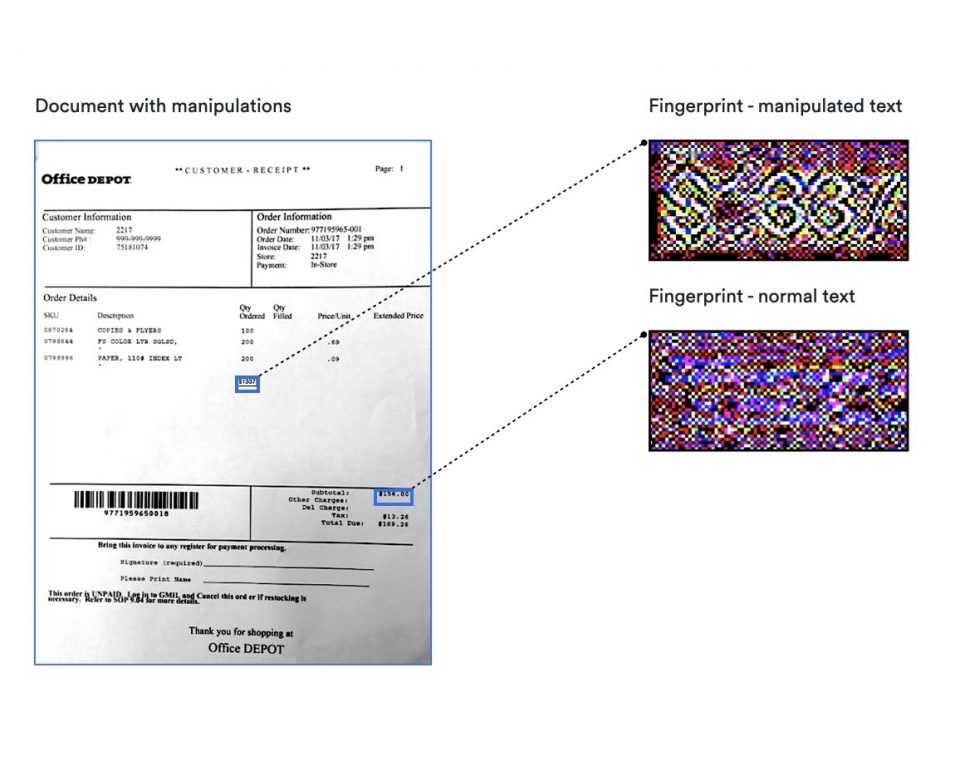Outsmarting document fraud
Jul 25, 2023 by Monique Sherman

Automation Hero introduces cutting-edge document forgery detection capabilities
In an age where document-centric processes are central to business operations, the risk of fraud and manipulation looms large. Insurance fraud, for instance, is estimated to cost more than $308 billion annually, causing the average U.S. family between $400 and $700 per year in increased premiums1. And, with increased digitization, many changes have been deployed at the front end; however, back-end processes and systems remain untouched, which raises the question: have all changes been assessed for their vulnerability to fraud?
Similarly, return fraud is a growing concern for retailers, accounting for over 10% of total retail returns and costing U.S. retailers $761 billion2.
To combat these issues, Automation Hero has stepped up its game by introducing new capabilities for its intelligent document processing platform that supports intelligent document forensics. Our advanced AI-powered platform helps determine if documents involved in any process have been potentially manipulated, combating fraud and ensuring authenticity.
Types of document forgery
Document forgery encompasses a wide range of deceptive practices involving the manipulation of documents to deceive others into believing they are genuine. Some common types of document forgery include:
- Signature forgery: Fraudsters alter or replicate signatures to misrepresent a document’s authenticity and authorization.
- Altered content: Documents are tampered with to change critical information, such as dates, amounts, or terms.
- Counterfeit documents: Criminals create completely fake documents to impersonate legitimate ones.
- Photocopy manipulation: Unauthorized alterations are made to photocopies of documents to present false information.
Common strategies in insurance fraud
Insurance fraud is a pervasive issue, and fraudsters adopt various strategies to deceive insurers. Some common strategies include:
- False claims: Policyholders submit claims for damages or losses that never occurred.
- Exaggerated claims: Legitimate losses are reported, but the claimant exaggerates the extent of damage or the value of lost items to receive a larger payout.
Challenges faced in fraud risk mitigation
While many insurers have dedicated fraud mitigation units, their effectiveness is often limited by various challenges:
- Problems with data quality: Insurers face data quality issues, including errors, omissions, and inconsistencies across different systems, impacting analytical tools’ efficacy.
- Limited use of analytical tools: The lack of advanced technology tools like predictive analytics and fraud detection systems hampers proactive and timely fraud detection.
- Issues with data protection and privacy: Stringent data protection policies can lead to limited access to crucial data, making fraud risk mitigation a significant challenge.
Detecting document forgery with advanced AI capabilities
In the digital era, document forgery has become more sophisticated, making traditional detection methods insufficient. To combat this, leveraging advanced AI capabilities is crucial. Some cutting-edge techniques to detect document forgery include:
- Image analysis: AI algorithms can scrutinize document images for irregularities, inconsistencies, and signs of tampering.
- Pattern recognition: Advanced AI can identify unique patterns in signatures and handwriting, distinguishing between genuine and forged content.
- Metadata examination: Analyzing metadata can unveil clues about a document’s origin and potential modifications.
- Text analysis: AI-powered algorithms can detect copy-paste or other text alterations that may indicate forgery.
Automation Hero’s intelligent document forensics methods
Automation Hero’s end-to-end platform seamlessly integrates document forensics, bolstering fraud risk mitigation. Some of the key methods utilized by the platform include:
- EXIF and XMP data analysis: Metadata within document files provides vital information about post-scanning alterations and the software used for modifications.

- Scan fingerprint analysis: Subtle patterns in document scans reveal manipulations that are barely visible to the human eye, exposing any anomalies.

- Copy-paste detection: This method identifies instances of identical text, exposing fraudulent alterations made by copying and pasting text.

In a world riddled with document forgery and manipulation, Automation Hero’s intelligent document processing platform is a game-changer. By leveraging advanced AI capabilities for intelligent document forensics, they enable businesses to detect potential fraud and ensure the authenticity of documents within their processes. This helps combat insurance fraud, reducing its staggering annual costs, and protects retailers from return fraud, enhancing profitability.
You can also check out our video below, which provides a demo.
Close Window
Automation Hero will track how you use the emails (e.g., at what time you open which part of the emails) sent by Automation Hero. If you have provided a separate declaration of consent that cookies for tracking your usage of the website and/or apps may be placed on your device, Automation Hero will also connect the information about your use of Automation Hero’s websites and apps (e.g., which information you open) collected by the tracking cookie to such information in so far as possible. Automation Hero will analyze such information, to identify your interests and preferences and to communicate with you in a more personalized and effective way, e.g. by providing information that you are likely interested in, like information on new technologies or products of the Automation Hero group that are likely relevant to you.
